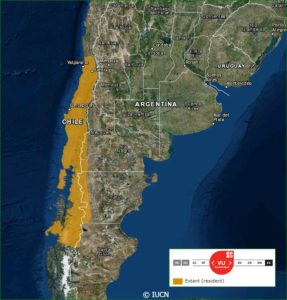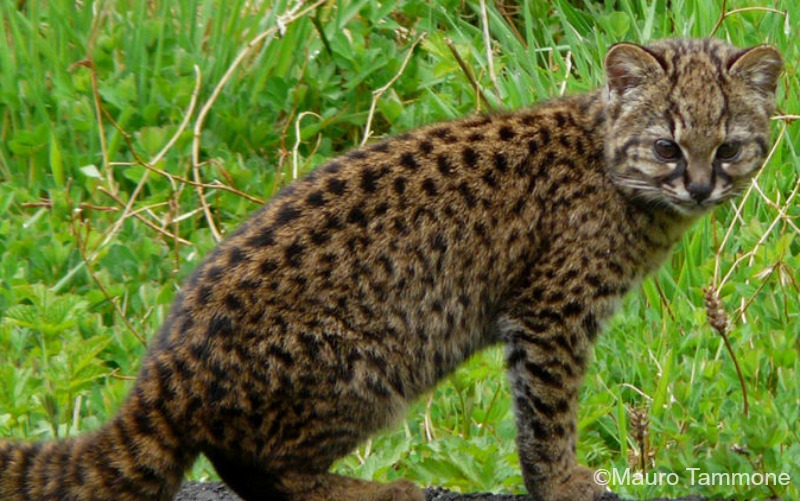- HB Length: 37-51 cm (14-20″)
- Tail Length: 20-25 cm (8-9.8″)
- Height: Unknown
- Weight: 1.5-3 kg (3.3-6.6 lbs)
- Pop. Trend: Decreasing
Kodkods Leopardus guigna are the smallest wild felid in the Americas and rival two other species for the title of smallest wild cat in the world. They are quite similar in appearance to the Geoffroy’s Cat Leopardus geoffroyi with which they share their distribution in Argentina, but are smaller, have a smaller face and a thicker tail.
The word Kodkod is the Araucanian Indian name for this cat, but local people call them the Guiña.
The ground colour of the coat varies from grey and reddish to buff or dusky brown, marked with small, roundish black spots. There are a few narrow black bands on the neck and crown, and the underparts are whitish. Their face is characteristically marked: from each eye a black line crosses the cheek under the eye and another solid black stripe rises vertically on either side of the nose to the crown.
The ears are small and rounded, the backs of which are blackish and marked with a white central spot. Their legs are short, and the foot pads fairly large with black soles. The tail is short, only about half of the head‑body length, and marked with 10 ‑ 12 conspicuous black rings, and a black tip. The tail of the Kodkod is very bushy, growing wider towards the tip. Melanistic individuals are known to occur. Males are larger than females, especially in the southern portion of their range.
Distribution

Kodkods have the smallest distribution of any cat in the Americas. They occur only in Central and Southern Chile, with marginal populations in adjoining areas of Argentina. In the Patagonian Mountain Forest of Argentina, the Kodkod population was found to be lower than that reported in Chile. This is likely due to the presence of the slightly larger Geoffroy’s Cat in the same area.
In central Chile most of the native forest has been replaced by plantations. One study (2004) of two coastal areas found that Kodkods preferred dense scrub habitats, far from roads and near protected forest patches. Researchers found plantation forest was only used if it was close to native forest or had native forest regeneration in the understory.
Their status in southern Chile is more secure, where human activity is less and there are several large protected areas. Researchers (2002) found the average home range to be 269 hectares with considerable overlap of ranges and core areas.
Home range size of Kodkods is 0.3-2.2 km² in Torres del Paine and Queulat National Parks, and 1.3-22.4 km² in a fragmented landscape on the northeastern coast of Chiloé Island, Chile.
Habitat
These cats are strongly associated with moist temperate mixed forests of the Andean and Coastal ranges, and range up to the treeline at 1,900 to 2,500 m.
Vegetation cover is an important ecological requirement for the Kodkod as it typically occurs in forest types with heavy understory. In its southern range, it is strongly associated with moist temperate mixed forests.
Kodkods seem to be relatively tolerant of altered habitat and are also recorded in secondary forest, pine or eucalyptus plantations, semi-open habitats or close to agricultural areas. Nevertheless, they are not observed using or crossing grazed pasture with vegetation less than 0.4 m high. It is assumed that vegetation cover corridors are important to connect larger habitat areas. This adaptability may be very relevant to the long term survival of these cats in an increasingly human-dominated landscape.
Ecology
Activity patterns of the Kodkod vary in different regions and they can be active day or night. They are good climbers, escaping to trees when threatened, or to shelter during inactive periods. Kodkods also rest in dense cover near waterways and in thick piles of ground-level vegetation. Daily distances covered by radio-tracked cats were up to 1.8 km in Torres del Paine and Queulat National Parks, and a maximum of 13.9 km in a fragmented landscape on the northeastern coast of Chiloé Island.
The ranges of males are often larger than those of females. Male and female home ranges overlap largely whereas home ranges of individuals of the same sex are exclusive. However, a radio-collar study in 2004 in Chile found spatial overlap both within and between sexes.
Kodkods are agile hunters and mainly hunt on the ground.The cats in southern Chile prey mainly on small mammals like rodents, marsupials and rabbits, but also on birds, lizards and invertebrates. They occasionally take carrion and predate on poultry.
Reproduction
Little is known of the Kodkod’s reproductive behavior. Gestation is thought to be 72 – 78 days, and one to three kittens are born. One female reached sexual maturity at 24 months. They have been known to live over 11 years in captivity but they have not been studied under captive conditions.
Threats
- habitat loss and fragmentation due to logging and agricultural activities
- habitat conversion to pine plantations with no understory vegetation
- direct persecution by humans
- killing by domestic dogs
- run over by automobiles
Conservation
Most people in rural landscapes of central and southern Chile have negative attitudes towards Kodkods, arguing livestock and poultry losses. Since the beginning of the past century, much exotic wildlife has been introduced to Argentinean Patagonia. This fauna has become part of important economic incomes of the region. In consequence, many native species are not being valued in any aspect as it is the case of the Kodkod. Regrettably, in some areas Kodkods are considered to be a harmful and worthless animal due to the predation of domestic poultry. Illegal killing seems to be quite frequent throughout its range.
The perception of people plays an important part in the conservation of these cats. Long-term conservation challenges outside protected areas will depend on the increase of local awareness to reduce conflict in areas where they are considered poultry pests, improving chicken coops and highlighting the services provided by its role as controller of mice – carriers of Hanta virus – and exotic European hares.
Another important challenge is preserving native vegetation corridors to provide connectivity between forest fragments or larger forested areas. Human populations and deforestation are increasing in the Chilean temperate rainforest and climate change may be an emerging additional threat. The conservation of Kodkods in private lands outside protected areas has also gained special relevance for the long-term persistence of its populations. A positive attitude of land owners towards these tiny cats is required.
More information about the ecological requirements, demographics, threats and status of the Kodkod is needed, along with continuous population monitoring to enable accurate long-term conservation measures.
Range Map IUCN Red List 2018
Updated 2018


Pat Bumstead
Tell everyone about the existence of these tiny cats, and how many mice and rats they eat each year. Feel free to print our fact sheet, and become a voice for the kodkods!
Emily Sance
I live in in Chile. What can I do to help the kodkod’s conservation?
Pedro Va
“Colo colo” is the common name of Leopardus colocolo.
“Huiña” or “Kod Kod” is the common name of Leopardus guigna.
They are very related species, closely resemble. So people tend to confuse them
Victoria Herrera
The Araucanian (Mapuche) word kodkod gave origin to Colo-Colo, the name for them in Chile. They are also called güiñas. They are beautifu animals.
Pat Bumstead
Yes, they are protected in both their range countries. Unfortunately enforcement of the laws is not always carried out in those countries due to lack of education and staff.
Vickie Barnes
Are kodkods protected